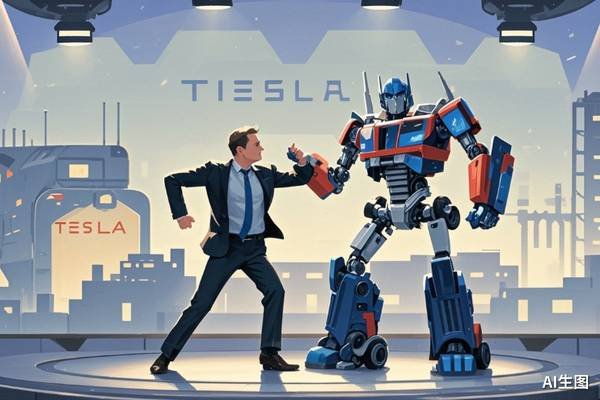Elon Musk, who danced with robots, has just won a high – stakes bet. The stake is not only the future of Tesla but also the tomorrow of the entire technology industry.
Inside Tesla’s Gigafactory in Austin, Texas, the atmosphere at the bustling shareholders’ meeting was electric with thunderous applause. Musk walked onto the stage amidst cheers and even danced a clumsy yet symbolically significant dance with the Optimus robot. On November 6th local time, Tesla shareholders approved a ten – year compensation plan for CEO Elon Musk with a 75% support rate.
This plan is nothing short of the largest bet in business history. If Musk achieves all the set goals, he will receive Tesla stocks worth approximately $1 trillion as compensation. This figure exceeds the entire GDP of Poland and is equivalent to earning $270 million per day or $188,000 per minute.
01 Sky – High Compensation
Musk’s trillion – dollar compensation is truly “unprecedented.” Looking back to 2018, Tesla’s board of directors had formulated a “ten – year $55 billion” compensation plan for Musk, which was then hailed as an “astronomical figure.” Who would have thought that just six years later, this figure would be refreshed to $1 trillion, a nearly 20 – fold increase.
When the results of the shareholder vote were announced, the atmosphere was electric. 75% of Tesla shareholders voted in favor. This scene inevitably reminds people of a similar situation six years ago when Musk’s compensation plan received 73% support. History often rhymes, but the stakes are now on a completely different scale.
As Musk walked onto the stage and danced with the robot amidst cheers, he excitedly stated, “Tesla is not only about to open a new chapter but also an entire ‘new book’ in the future.” His excitement is understandable, as this compensation plan will determine his life trajectory for the next decade.
This compensation plan has drawn so much attention because of its unprecedented scale. According to the real – time data from the Forbes Billionaires List, Musk’s current net worth exceeds $500 billion, making him the world’s richest man. This compensation is almost twice his existing assets, enough to buy the entire Nike or cover NASA’s budget for twenty years.
02 Underlying Reasons
Why is Tesla’s board of directors willing to offer such sky – high compensation? The answer is simple: to retain Musk. However, the deeper reason is that Tesla is at a crossroads of survival.
Tesla’s board of directors clearly stated that if the plan fails to pass, Musk may step down, which would cause significant losses to the company. Board Chair Robin Denholm said bluntly at the meeting, “Simply put, without Musk, there would be no Tesla today, let alone a Tesla tomorrow.”
Musk has repeatedly expressed that if he cannot obtain greater voting rights or compensation incentives, he may be inclined to focus on other ventures. In fact, Musk’s time is already stretched thin among his six companies: Tesla, SpaceX, X platform, Neuralink, Boring Company, and xAI. This compensation plan is essentially a “talent retention” strategy aimed at locking in Musk’s creativity for Tesla.
The deeper reason is that Tesla is trying to transform from an electric vehicle manufacturer into a “giant” technology company integrating artificial intelligence and robot development. Denholm emphasized at the meeting, “We are on the eve of an AI revolution, and Mr. Musk is the best person to lead us into this revolution.”
03 Stringent Conditions
It won’t be easy for Musk to get his hands on that $1 trillion. This compensation plan is actually a ten – year “performance bet” as challenging as climbing Mount Everest.
He must achieve 12 sets of increasingly difficult performance targets over the next decade to receive the $1 trillion worth of stocks in installments. The market – value target is the most astonishing – Tesla’s market value needs to increase from the current approximately $1.5 trillion to $8.5 trillion, more than a five – fold increase. This figure is nearly six times Tesla’s current market value. If achieved, Tesla would become one of the highest – valued companies in human business history.
The operational targets are equally challenging: delivering 20 million vehicles, which is twice the current global electric vehicle market volume; putting 1 million fully autonomous “robot taxis” into commercial operation; delivering 1 million humanoid robots; having over 10 million active FSD subscription users; and achieving an adjusted EBITDA of $400 billion, a figure that exceeds the combined profits of Amazon and Apple.
Any one of these targets is extremely difficult, let alone achieving them all. Take robot taxis as an example. No country in the world has approved the commercial operation of fully autonomous vehicles yet. For Tesla to reach the scale of one million in ten years, it needs to make breakthroughs in both technology and regulations.
According to the agreement, Musk will receive a total of approximately 423.7 million Tesla shares in 12 installments, accounting for about 12% of the company’s adjusted total equity. Every time he achieves a market – value target and an operational target, he can unlock a batch of shares. If all targets are met, Musk’s stake in Tesla will increase from 13% to about 25%.
04 Governance Controversy
This sky – high compensation plan has been controversial since its proposal, causing quite a stir in the investment community.
The opponents are mainly worried about two major issues: equity dilution and key – person risk. Norway’s sovereign wealth fund clearly stated its opposition to the plan before the shareholders’ meeting. The fund’s head, Caroline Smith, said in a statement, “This compensation plan is too large in scale, which may overly dilute the rights and interests of other shareholders and make the company overly dependent on a single person.”
Meanwhile, the substantial share rewards will inevitably lead to the dilution of existing shareholders’ shares. When the company issues new shares to Musk, the equity ratio of other shareholders will decrease accordingly. Some analysts estimate that if all the rewards are cashed in, the equity of existing shareholders will be diluted by about 12%, which means the value of each shareholder’s shares will be discounted.
In addition, critics also point out that tying the company’s fate further to one person may lead to a decrease in corporate governance and stability. Chris Ailman, the chief investment officer of the California State Teachers’ Retirement System, said bluntly, “It’s like building a skyscraper with only one load – bearing column. The risk is too high.”
What’s even more worrying is that Musk has been frequently involved in political issues in recent years, from the acquisition of Twitter to speaking out on the US – Mexico border issue. These actions have begun to affect Tesla’s brand image. Some consumers have said on social media, “I like Tesla’s electric vehicles, but I don’t like Musk’s political stance.”
05 Perilous Situation
As Musk danced with the robot to celebrate, he should not forget that Tesla is currently facing numerous crises that could turn the trillion – dollar compensation plan into a pipe dream.
Tesla’s revenue declined in the first half of this year. Apart from the intensifying competition in the electric vehicle market and outdated models, Musk’s political stance is also a major reason. A report from market research firm Caliber shows that Tesla’s consideration rate in the US has dropped from 70% in 2021 to the current 46%, which is closely related to Musk’s controversial remarks.
In North America and many European countries, protesters demonstrated against Musk, and Tesla was also affected. Some showrooms were damaged, and sales plummeted. Reports indicate that Tesla’s sales in Germany in October dropped by more than half year – on – year, and sales also declined significantly in many European countries, including Spain, the Netherlands, and the Nordic markets, in October.
Meanwhile, Tesla’s core technology is facing severe challenges. The Autopilot technology has had frequent problems and has caused several fatal accidents. The US National Highway Traffic Safety Administration is investigating it. The Robotaxi is still in the R & D stage and still requires a safety driver. There is still a long way to go before true commercialization.
The industry watchdog “Safe Autonomous Vehicles” pointed out that Musk’s compensation plan actually creates “dangerous financial incentives” that may lead to the hasty deployment of autonomous driving technology before its safety is proven. Missy Cummings, the head of the organization, warned, “When the trillion – dollar compensation is tied to the technology implementation schedule, safety often takes a back seat.”
06 Future Bet
Despite the many challenges, Tesla shareholders still approved this sky – high compensation plan. In essence, it is a high – stakes bet on the “AI + robot” revolution, with the entire future of Tesla as the stake.
In his subsequent speech, Musk outlined a clear vision: Artificial intelligence will become the dominant force in the automotive and robot industries, and Tesla must ensure that this force is “controllable, usable, and trustworthy.” He predicts that in the near future, Tesla’s robot business will be more valuable than its automotive business and become the company’s new growth engine.
He revealed that Tesla is shifting its focus from simply selling electric vehicles to the self – driving business, including building a fleet of robot taxis and humanoid robots. According to his vision, in the future, Tesla will no longer be just a car manufacturer but a “mobility – as – a – service” company. People will no longer buy cars but call for autonomous taxis on demand.
Musk also announced that Tesla will start mass – producing the driverless taxi Cybercab in April 2026. This fully autonomous vehicle without a steering wheel or pedals will be piloted in specific areas first.
Regarding the robots that have attracted much attention from the capital market, Musk said that he believes robots will be “the biggest product in history,” far surpassing mobile phones and anything else. He predicts that within ten years, there will be at least 1 billion robots working in various fields around the world, and Tesla hopes to dominate this market.
07 Echoes of History
This trillion – dollar compensation bet inevitably reminds people of similar moments in business history. In 1997, when Apple’s board of directors invited Steve Jobs back, it also faced doubts. In 2000, when Jeff Bezos of Amazon formulated a long – term strategy, he also encountered misunderstanding. History has proven that great companies often emerge from seemingly impossible bets.
However, what sets this bet apart is its unprecedented scale, longer time span, and more ambitious goals. Tesla not only needs to make technological breakthroughs but also reshape the entire transportation ecosystem and even change the way humans coexist with machines.
Adam Jonas, an analyst at Morgan Stanley, wrote in his latest report, “This may be the boldest compensation plan in business history. It’s not just about money but a public referendum on the future technological path.”
After the shareholders’ meeting, Musk stood on the stage, with the robot in the background dancing nimbly. This scene seems to be a metaphor for Tesla’s future vision – a world dominated by artificial intelligence and robots.
Reuters calculated that if Musk really achieves all the goals, he will earn $167,000 per minute and $240.5 million per day. But this money won’t come easily.
Tesla’s shareholders have made their choice. They have placed their bets on Musk’s vision. And global investors are also voting with their money, as Tesla’s stock price rose in after – hours trading after the plan was approved.
There are only two paths ahead for Musk: to create the greatest miracle in business history or to leave behind an unfulfilled high – stakes bet. In this era of rapid technological advancement, we are all witnesses to this trillion – dollar bet.
This article is from the WeChat official account “Investment Banking Circle,” author: Investment Banking Circle. Republished by 36Kr with permission.


Leave a Reply